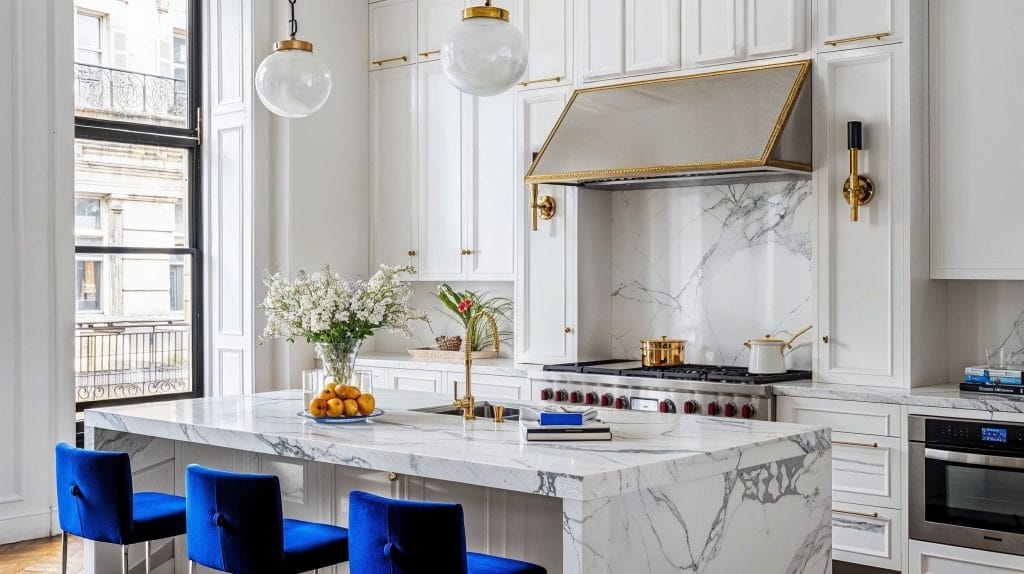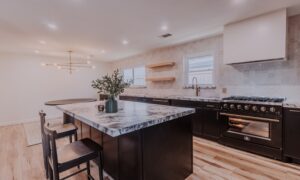The kitchen has always been the home’s heartbeat. But in 2025, it’s also becoming the home’s brain—part design lab, part command center, and part wellness hub. If you’re planning a makeover, it’s no longer just about picking a prettier tile. Today’s kitchen remodeling services are weaving in new technologies that make spaces safer, more efficient, easier to maintain, and tailored to the way you actually live. From AI-assisted layouts to healthier air and water, here’s how the smartest pros are raising the bar—and what to ask for when you hire one.
1) From Mood Boards to Mixed Reality: Smarter Design Discovery
AR/VR walk-throughs
Before you spend a dollar on cabinets, leading remodelers can drop you into a life-size virtual version of your future kitchen. With a headset or even a phone, you can “walk” the aisle between island and oven, test sight lines from the sink, or see how tall a backsplash should be behind the range. Small tweaks now—moving a pantry door 6 inches, widening a walkway to 42 inches—prevent expensive change orders later.
AI-assisted space planning
AI tools now analyze your room dimensions, daylight patterns, and traffic flow to propose multiple layout options in minutes. Prefer baking? The software clusters your wall oven, cooling racks, and a pull-out spice bank where you need them most. Have kids? It flags pinch points and suggests rounded edge profiles, anti-slam hardware, and a safer microwave drawer height.
Material visualizers
High-fidelity renderers let you swap countertop slabs, flooring, and cabinet finishes in real time under different lighting conditions. You can compare a rift-sawn white oak against a walnut stain or preview a matte black faucet with satin brass hardware—not in a flat mockup, but in your own room geometry. Expect kitchen remodeling services to provide these previews as a standard deliverable.
2) The Interoperable Kitchen: Appliances That Actually Talk
Open ecosystems over isolated gadgets
The gadget era is fading. Instead of a dozen apps, more pros are specifying ecosystems that centralize controls—lighting, shades, leak sensors, and appliances—into one interface. Think of it as “home OS” for cooking: preheat the oven, cue task lighting, and lower the shades when the range gets to temp.
Smarter appliances without the gimmicks
Features are maturing beyond novelty:
- Precision induction cooktops provide granular temperature control and auto-pan detection, making searing and simmering more consistent (and safer) than gas or legacy electric.
- Adaptive ovens use sensors to monitor internal humidity and adjust cook cycles for better results—no probing, no guesswork.
- Connected dishwashers optimize cycles based on load sensors and water quality data, extending the life of glassware and cutting utility costs.
- Voice shortcuts let you ask for task lighting, a 3-minute pasta timer, or hands-free vent hood boosts when pots start to boil.
When interviewing kitchen remodeling services, ask how they ensure different brands play nicely together and what local integrators they partner with for system setup.
3) Energy, Efficiency, and the Cost of Ownership
Remodeling is the best time to future-proof for lower utility bills and a smaller carbon footprint.
- Electrification-ready layouts: If you’re moving from gas to induction or adding a high-efficiency electric oven, plan for upgraded circuits, appropriate breakers, and dedicated outlets.
- Smart ventilation: Auto-sensing range hoods ramp up when particulate or heat levels rise and drop to quiet modes later. Proper duct sizing and makeup air planning reduce noise and improve capture efficiency.
- Lighting that earns its keep: Layered LED plans (ambient, task, accent) with smart dimming can slash lighting loads while improving visibility for chopping and cleanup.
- Thermal comfort: Under-cab toe-kick heaters, ceiling fans with smart thermostats, and better envelope sealing around new windows keep the kitchen comfortable without cranking the HVAC.
Tip: Ask your remodeler about available local incentives for high-efficiency appliances and electrification upgrades. Many kitchen remodeling services now include incentive navigation as part of the project management.
4) Wellness-Centered Kitchens: Clean Air, Clean Water, Clean Surfaces
Kitchens are high-activity zones where air quality and hygiene matter.
- Air quality sensors monitor PM2.5, VOCs, and humidity, triggering ventilation scenes and sending alerts if levels spike when cooking.
- Advanced filtration at the tap (under-sink multi-stage or whole-home systems) improves taste and reduces contaminants, while touchless faucets cut cross-contamination mid-meal.
- Antimicrobial and low-VOC materials—from non-porous quartz to sealed composite sinks—are now easy to spec without sacrificing style.
- Leak detection under sinks, fridges, and dishwashers shuts water off automatically and pings your phone—one of the cheapest, highest-ROI protections you can add.
The smartest kitchen remodeling services package wellness upgrades into clear tiers so you can choose good/better/best options.
5) Digital Fabrication Meets Craft: Faster, Cleaner Builds
Technology isn’t replacing craftsmanship—it’s giving it superpowers.
- Laser/LiDAR site scans capture exact room geometry, speeding up cabinetry and countertop templating and reducing installation surprises.
- CNC-cut components produce tighter tolerances for drawer boxes, custom panels, and specialty trims. That means doors align better, gaps shrink, and installs go faster.
- Modular and off-site assembly for cabinets or ceiling clouds allows more work in controlled shop environments (read: fewer dust days in your home) and condensed timelines once onsite.
- 3D-printed brackets and jigs make one-off problem solving cheaper—think a custom filler piece that perfectly bridges a quirky corner.
Ask prospective kitchen remodeling services for a peek at their production pipeline: Do they share shop drawings? How do they QC pieces before delivery? The best teams show you.
6) Project Management, But Make It Transparent
The tech you don’t see matters just as much.
- Client dashboards consolidate selections, invoices, schedule milestones, and change orders. No more hunting through email threads.
- QR-coded components link to maintenance manuals and finish specs. Scan a toe-kick label to pull up the exact paint formula or a how-to video for hinge adjustments.
- Supply-chain visibility flags potential delays early so you can choose alternates before a backorder derails the schedule.
- Digital twins—as-built models updated during construction—become a permanent record for future upgrades (or the next owner).
When evaluating kitchen remodeling services, ask to see a sample dashboard and reporting cadence before you sign.
7) Privacy, Security, and Resilience (Because Kitchens Shouldn’t Go Offline)
A connected kitchen should be convenient—not creepy.
- Local control where possible: Favor devices that keep core functions running without cloud access. Your lights and cooktop shouldn’t “need the internet.”
- Network segmentation: Place smart appliances and IoT gadgets on a separate home network (many modern routers make this simple).
- Update and backup plans: Your remodeler or integrator should document how firmware updates happen and how system settings are backed up.
- Open standards and expandability: Choosing devices that support widely adopted protocols reduces the risk of orphaned hardware in a few years.
Reputable kitchen remodeling services now present a simple one-page data and device policy as part of the proposal—if you don’t see one, ask for it.
8) Budgeting for Tech Without Blowing the Build
Good news: you don’t need to buy everything at once. Think of your tech plan in layers:
- Infrastructure (must-haves): Dedicated circuits, low-voltage runs, ethernet to key spots, proper ventilation ducting, and blocking for heavy wall items.
- Core upgrades (high-impact): Induction cooktop, smart hood, layered lighting with dimming, leak detection.
- Quality-of-life add-ons (nice-to-have): Voice scenes, interior cabinet lighting, in-drawer charging, motorized shades.
- Future-ready provisions: Extra conduit and blank boxes so upgrades are easy later.
Ask your remodeler to label items by layer on the estimate. The best kitchen remodeling services help you phase features while keeping the bones upgrade-friendly.
9) A Quick Homeowner Checklist
Use this to start a smarter conversation with your contractor:
- Can we do an AR/VR walkthrough before final approvals?
- What’s your plan for interoperability so I’m not juggling apps?
- How will you improve ventilation effectiveness and measure it?
- Which wellness features (air, water, antimicrobial surfaces) do you recommend at my budget?
- What incentives or rebates might apply to efficiency upgrades?
- Do you provide a client dashboard for selections, schedule, and change orders?
- How do you handle data privacy, local control, and firmware updates?
- What’s included in the as-built documentation (photos, models, serial numbers)?
- If I phase features, what infrastructure should we rough-in now?
The Bottom Line
The smartest remodeling projects in 2025 aren’t defined by flashy gadgets or trend-chasing finishes. They’re defined by systems—design, energy, wellness, fabrication, and project management working together. The right kitchen remodeling services will help you see your kitchen not just as an attractive room, but as a durable, efficient, healthy, and upgrade-ready platform for the next decade. If you build the bones right and choose interoperable, human-friendly tech, you’ll get a kitchen that feels as good on day 2,000 as it does on day one—long after the novelty of that new backsplash has faded.



































